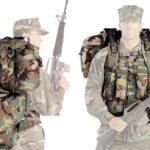Backpacks
The word backpack was coined in the United States in the 1990’s. Backpack, also called a ‘Kitbag’, ‘Knapsack’, ‘Rucksack’, ‘Haversack’, ‘Sackpack’ or simply ‘Pack’, is in its simplest form a cloth sack carried on one’s back and secured with two straps that go over one’s shoulders. The term ‘Knapsack’ was the usual name for a rucksack or backpack up until the middle of the 20th century. ‘Bergen’ is another word for a large Alpine-style load carrying rucksack used by the British Army during the Second World War and thereafter as well, named after its designer Norwegian Ole F Bergen, end combined with the Norwegian city of the same name.
Backpacks form an essential part of the gear of the outdoor trekker and the urban backpacker, allowing more mobility and compactness than would be available to someone carrying most of their gear and clothing in a suitcase.
Backpacks lend us the ‘hands free advantage’, that is, they keep hands devoid of clutter and assist in holding multiple items or doing other work. They also pave the way for safer and smoother journeys. In addition to their use in outdoors pursuits, backpacks are sometime used in other sports as well. Hydration packs, sometimes used by athletes and military personnel, to carry water (in either a bladder or a rigid bottle) and have a tube connected to them from which the wearer can drink without removing the pack; this feature is also included in some more general-purpose hiking backpacks.
Backpack Size/Capacity
Backpack sizes are determined by their use.
What size pack do your really need?
Get a pack that is too big and you will be sure to fill it with non-essential junk and end up tired and sore. But go too small, and you might not be able to fit the stuff you do need, life safety gear. Backpack sizes are listed in either cubic inches or more commonly in liters (L), which can make comparison-shopping a bit tricky, especially for on-line shoppers who are not able to actually see the packs before they buy. The following provide general rule of thumb guideline and will also depend on the sizes of the items you will pack.
Generally, one can categorize usage as;
- Day Pack
- Weekend Pack
- Multi-day Pack
- Expedition Pack
- Tactical Backpacks
Backpacking sizes liters to cubic inches conversions:
|
Size in Liters (L) |
Capacity
in Cubic Inches |
Usage |
| 10L | 600 inch3 | 1/2 Day Hike |
| 20L | 1,200 inch3 |
Day Hike |
| 30L | 1,800 inch3 | |
| 40L | 2,400 inch3 | |
| 50L | 3,000 inch3 | Weekend Hike |
| 60L | 3,700 inch3 | |
| 70L | 4,300 inch3 | Multi-Day Hike |
| 90L | 5,400 inch3 | |
| 90L> | 6,000 inch3> | Expedition |
FORCLAZ 30 & 40 AIR Backpacks
WEEKEND BACKPACKS
FORCLAZ 50 Grey
FORCLAZ 60 – Blue
FORCLAZ 70 – Khaki
FORCLAZ 70 – Grey
MULTI-DAY BACKPACKS
FORCLAZ 90
TACTICAL BACKPACKS
Tactical Backpacks are a standard part of the load-bearing equipment of soldiers, especially infantry and also police tactical units, in most countries.
Tactical/military-style packs are regularly available to civilians as well. Well-known examples include the United States ALICE field pack and the British Army PLCE rucksack attachment, both of which are widely available to civilian markets both as actual military surplus (new or used) and as replicas. Such packs are often equipped with, though not always (e.g. the US Marine Corp’s ILBE pack), external-frame packs, with the pack itself lashed or pinned to a metal or plastic carrying frame. For units that are entering combat situations, packs may be loaded heavily and can weigh in excess of 100 lbs. Each soldier may carry extra weapons, ammunition, rations, medical supplies, tents or other shelter material, and extra clothing.
Some more recent military/tactical designs, especially the MOLLE and ILBE packs used by the United States armed forces, are covered with webbing loop attachment points for increased carrying capacity.
Players of military-style combat games such as paintball and airsoft, use these military-style tactical backpacks and webbing for storing gear and ammunition.
Tactical Backpacks are great for organized storing of equipment, gear/kit and supplies, due to the compartmentalization and ease of access, both very critical in combat. Therefore, they are very popular with Adventure and Outdoors persons, Preppers – who prepare themselves for emergency situations and even for the well organized urban commuter who wish to have all his Every Day Carry items properly organized and stored for easy access.

Molle System
MOLLE (pronounced ‘molli’, as in the female name Molly) is an acronym for Modular Lightweight Load-carrying Equipment. It is used to define the current generation of load-bearing equipment and backpacks used by a number of NATO armed forces, especially the British Army and the United States Army. The system’s modularity is derived from the use of Pouch Attachment Ladder System (PALS) webbing as rows of heavy-duty nylon stitched onto the vest to allow for the attachment of various compatible pouches and accessories. This method of attachment has become a de facto standard for modular tactical gear, replacing the All-purpose Lightweight Individual Carrying Equipment (ALICE) system used in the earliest modular vest systems.









































